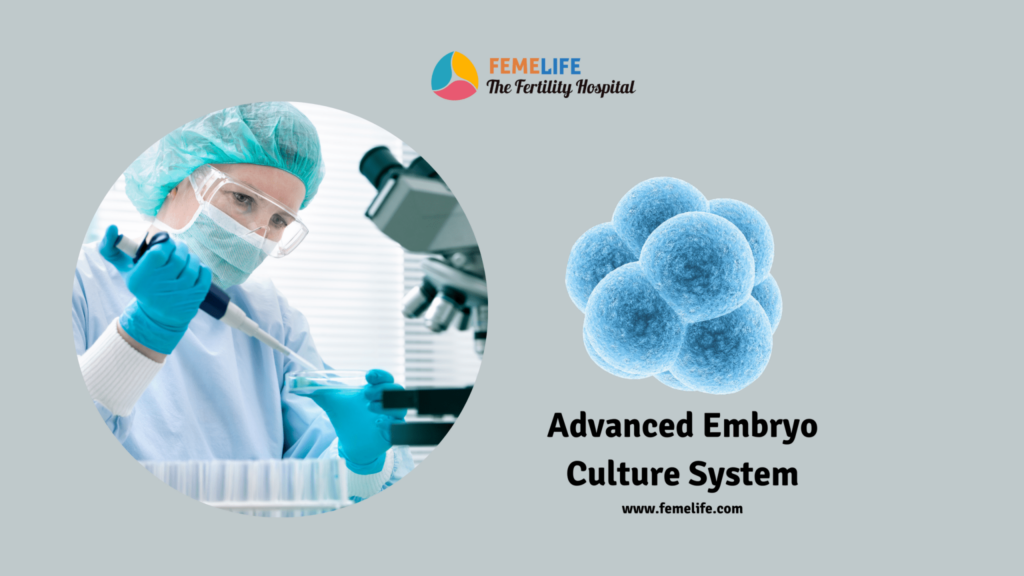Embryo Culture
Embryo culture is a system of a specific combination of environmental conditions. It includes technical equipment and particular nutrients for the embryos to grow. The most important issue for the growth of embryos is the environment. IVF laboratory provides a strict embryo culture condition. Here in the laboratory, the embryologists maintain a stable environment for your growing embryos. In order to optimize this “environment”, in our Femelife fertility foundation IVF lab, we tightly control all conditions affecting the embryo. Various such factors are light, temperature, humidity, and the concentration of gases. These factors help each of your embryos while incubated within the lab. Even minor variations in these conditions can also have a devastating effect on embryo growth, development, and IVF success.
What does an embryo need to grow?
At Femelife, our IVF laboratory has incubators to culture embryos. Usually, embryos are grown in a delicate micro-environment. Here, strict control of temperature (37˚C) is essential. Culturing your embryos will require humidity (90%), and a mixture of three gases; carbon dioxide (5.5%), oxygen (5.0%), and nitrogen (89.5%). At Femelife balance of the gases is maintained correctly. Another very important factor is that the growth media which is used to culture the embryos and growth development.
We use a series of different media that are formulated to provide the most beneficial nutrients to the embryos at each different stage of development and growth. We move the embryos from one media to another media as they grow, as each stage of development has its own unique requirements for optimal growth.
What are the culture media for embryos?
In our IVF laboratory, we use three different kind of media to culture embryos.
- First is fertilization media, which is used to promote the fertilization of the oocytes or eggs.
- The second is cleavage media, it has specific nutrients to assist the embryo in early development from the one-cell stage to around the eight-cell stage which is on 3 days of implantation.
- Third, is blastocyst media; it contains a different set of nutrients that helps the embryo continue to develop from eight cells to multiple cells.
Nutrition in embryo culture
Each type of media is designed to deliver the proper nutrients to the embryos for the development at the time when they are needed the most. For instance, embryos don’t use a lot of glucose intially. Afterwards, as it develops glucose utilisation increases. On day three as the embryo starts toward a blastocyst, it needs more of glucose. Subsequently, on day three, the embryos are moved to a media that has a greater concentration of glucose.
Do the embryos need to breathe?
The embryo culture media is also chemically buffered to provide a stable pH for the embryos to grow in the petri dish.
Embryo culture pH is controlled by the concentration of carbon dioxide maintained inside in the incubator. The fluctuating levels of carbon dioxide changes the pH of the media. This partially explains why it is critically important to maintain the concentration of different gases. So, carbon dioxide and oxygen in the incubators are maintained in a very tight range.
How do the embryos survive?
Embryos are be grown on small drops of media in a petri dish. These media drops are covered with a layer of culture oil. This media layer of oil helps to keep the pH fluctuations to a minimum by allowing for a slow exchange of carbon dioxide from the surrounding environment to the media in which the embryos are growing healthy. This incubator slowly exchange of gas and the stable pH that it creates are very important for the development of the embryos.
In our lab embryo culture system was developed to mimic the environment found in the female reproductive tract.
Why do we nurture embryos?
Embryos are grown as a part of IVF treatment. An environment that closely resembles the natural circumstances of conception can result in good embryos. In our Femelife IVF laboratory the same advantages are available to your developing embryos. These conditions are like normal environment inside the female reproductive system. This combination of proper incubator settings, media pH, and specific nutrients gives ideal growth environment. This will hopefully be a recipe for the successful development of embryos.
What are the types of embryo culture media?
Embryos can either be cultured in artificial culture medium or in an autologous endometrial coculture. In otherwords, a layer of cells from the woman’s own uterine lining serves as culture medium for embryo. In artificial culture medium, if the same culture medium is used throughout the period it is termed monoculture medium. Likewise, in sequential system embryo is progressively placed in different media. Consequently, these different formulations are based on the different concentration and composition of the tubal and uterine fluid in relation to change in the need of the embryo. To illustrate, when culturing to the blastocyst stage, one medium may be used for culture first 3 days which then changed after 3 days.
Which medium is better for embryo culture?
Embryo culture can be performed in either single or sequential medium effectively. As a result both type of media are used for the culture of human embryos to the blastocyst stage. In conclusion, all artificial embryo culture media contains glucose, pyruvate, and energy-providing components. Certain substances like antioxidants, antibiotics, macromolecules, hormones and growth factors can be added to the embryos. Addition of amino acids, nucleotides, vitamins, and cholesterol and some more minerals improve the performance of embryonic growth and development. Blastocyst culture is important for patients undergoing PGD and noninvasive embryo screening.
At Femelife Fertility, we employ advanced methods to permit dynamic embryo culture. These include fluid flow and embryo movement in our lab. Recently a method has been developed to use the uterus as an incubator. The natural fluids inside the uterus can be used as culture medium.

